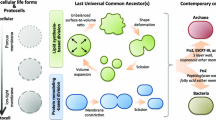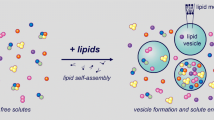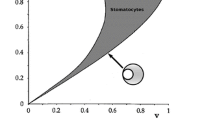Abstract
Self-reproduction is one of main properties that define living cells. In order to explore the self-reproduction process for the study of early cells, and to develop a research line somehow connected to the origin of life, we have built up a constructive ‘synthetic cells (minimal cells)’ approach. The minimal cells approach consists in the investigation of the minimal number of elements to accomplish simple cell-like processes – like self-reproduction. Such approach belongs to the field of synthetic biology. The minimal cells are reconstructed from a totally reconstituted cell-free protein synthesis system (PURESYSTEM) and liposome compartments as containers. Based on this approach, we synthesized two membrane proteins (enzymes), GPAT and LPAAT, which are involved in the phosphatidic acid biosynthesis in bacteria. Both membrane proteins were successfully synthesized by PURESYSTEM encapsulated inside POPC liposomes. Additionally, the enzymatic activity of GPAT was restored by mixing the expressed enzyme with lipid and by forming liposomes in situ. Through these experimental evidences, here we present a possible model to achieve self-reproduction in minimal cells. Our results would contribute to the idea that early cells could have been built by an extremely small number of genes.
Similar content being viewed by others
Introduction
Self-reproduction is one of the most important features of life. To accomplish this task, modern living cells possess highly organized and complicated mechanisms. However, when we think about the most primitive cells, which are assumed to be in very early state of living complexity, they might not have such advanced systems for reproducing themselves. It is more natural to think that the early cells were more simple and crude than the present living cell (some authors have defined these cells as “limping”, see Luisi et al. 2006). Only after a long evolution the living cells have acquired the present life-related properties. How can cells reproduce themselves in a simple way? To answer this question, we are investigating the so-called Minimal Cells (Luisi 2002), using a top-down approach that is also related to synthetic biology. Minimal Cells are constituted by combining two well-established techniques: liposome formation from colloid and biophysical chemistry and cell-free protein synthesis from molecular biology. Based on this approach, here we present a possible model to achieve the self-reproduction of Minimal Cells. The main idea is to synthesize the lipid forming the liposome membrane within the liposome itself, by means of enzymatic reactions. The endogenous biosynthesis of phosphatidic acid (PA) takes place as a stepwise binding of two acyl-chains into a glycerol substrate, following the first two steps of the so-called lipid salvage pathway. In Escherichia coli, two enzymes are involving in this pathway, namely, sn-glycerol-3-phosphate acyltransferase (GPAT) and 1-acyl-sn-glycerol-3-phosphate acyltransferase (LPAAT). The GPAT catalyzes the acyl-chain binding at position 1 of a glycerol substrate, and it is known to be an integral membrane protein (Wilkison and Bell 1997). LPAAT is a membrane-associated protein located in the cytoplasm, which catalyzes the acyl-chain binding at position 2 of 1-acyl-glycerols (Coleman 1992). Therefore, we are aiming that, through synthesizing of both membrane proteins inside liposome, phosphatidic acid is biosynthesized by the joint catalytic activities of both enzymes. Moreover, the resulting increase of the number of phospholipids molecules in the membrane would stimulate a destabilization and spontaneous self-division of liposome compartment (Fig. 1), as it was demonstrated in model fatty acids-based systems by Luisi and coworkers (Walde et al. 1994).
A model of self-reproduction. GPAT and LPAAT are synthesized by a reconstructed cell-free system (PURESYSTEM), which encapsulated inside liposome compartments. Synthesized proteins are localized on membrane surface in order to be enzymatically active. Based on the enzymatic activity of both proteins, G3P and acyl-CoA supplied from outside of liposome can be converted to LPA and PA, stepwisely. The newly synthesized lipids are incorporated into lipid bilayer of preexistent liposomes and a certain amount of increase of lipid would stimulate the destabilization of liposome conformation. As a result, a liposome will be divided by mean of thermodynamic stability. G3P glycerol-3-phosphate, GPAT sn-glycerol-3-phosphate acyltransferase, LPAAT 1-acyl-sn-glycerol-3-phosphate acyltransferase, PA phosphatidic acid
Results
Protein Synthesis in PURESYSTEM
PURESYSTEM (Protein synthesis Using Reconstructed Elements System) is a cell-free protein synthesis system reconstructed from 36 enzymes and 70 S ribosomes (Shimizu et al. 2001). This set of component is the minimal number of factors fulfilling the transcription and translation reactions. An advantage of using the PURESYSTEM is that any unknown factors and reactions can be eliminated in the system, providing an exceptional tool to construct and study synthetic cells which model early cells. It should be noted here that the minimal cell approach does not mimic the primitive cells in the sense of molecular adherence to primitive enzymes or genes. The focus is on minimal functions, or minimal number of elements.
First of all, GPAT and LPAAT were synthesized from the plasmid DNAs containing plsB and plsC genes, respectively. A couple of genes are constructed downstream of T7 promoter with the Shine–Dalgarno sequence, for the gene expression of plasmid DNAs. Protein synthesis reaction was performed in the presence of [35S]methionine. The products were analyzed by SDS-PAGE gel and visualized by autoradiography. On the SDS-PAGE gel, radio isotope labeled GPAT and LPAAT were observed as bands which located at 83 and 27 kDa, respectively, comparing with the marker proteins. This result fully agrees to previous reports (Wilkison and Bell 1997; Coleman 1992). Interestingly, the PURESYSTEM leads to a minor amount of intermediate products as compared with the case of other cell-free expression systems (for example the commercially available E. coli extracts). This fact indicates that protein synthesis has proceeded efficiently and that PURESYSTEM can be effectively used for further steps in our project. Next, PURESYSTEM was encapsulated inside liposomes, which consist of 1-palmitoyl-2-oleyl-sn-glycero-3-phosphocholine (POPC), and the two proteins were synthesized inside liposome compartments. In order to form liposomes, the PURESYSTEM components and template DNA were mixed with POPC lipid film and, subsequently subjected to bath sonication and vortex to dissolve the lipids completely (final lipid concentration was 200 mM). After liposome formation, RNase A was additionally added into the mixture to inhibit external protein synthesis and evaluate the yield of protein only inside liposomes. In fact, RNase A cannot penetrate inside POPC vesicles. Based on this procedure, both proteins were synthesized inside POPC liposomes. Whereas in the absence of liposomes the GPAT synthesis was completely inhibited by the addition of RNase A (lanes 1 and 2, Fig. 2a), almost 5–10% of GPAT synthesis was observed in the presence of POPC liposomes (lanes 3 and 4, Fig. 2a). The same result was observed also in the case of LPAAT. Interestingly, when both DNA templates were introduced in the system, we observed the simultaneous GPAT and LPAAT synthesis. Since the plasmids are not present at low concentration, it is assumed that the large fraction of liposomes contains both templates and therefore the two proteins were synthesized in the same compartments. Strictly speaking, however, this cannot be demonstrated from the above mentioned data. Future developments will aim to insert both genes in a single plasmid.
Protein synthesis inside liposomes and its conserved activity. a GPAT was synthesized in the presence (lanes 1, 2) or absence (lanes 3, 4) of POPC liposomes (LPs). Before starting the reaction, RNase A (RN) was added in order to evaluate a yield only inside LPs (odd lanes). Synthesis reaction was performed at 37°C for 3 h and the products were precipitated by acetone and washed with ether before running SDS-PAGE. The samples without RN were loaded only 10% of product, and 100% of samples with RN was loaded. The gel was dried and visualized with a phosphorimager and MultiAnalyst software (BioRad). The position of marker protein is indicated. b The recovering of GPAT activity with the help of lipid was analyzed by observing the substrate conversion from grycerol-3-phosphate (G3P) to lysophophatidic acid (LPA). GPAT was synthesized from the responsible gene DNA in PURESYSTEM (PS) (equal sample of lane 1, A) and mixed with E. coli total lipid extraction (TL) to form liposomes. The assay of GPAT activity was performed in the presence of G3P, Palmitoyl-CoA, and [14C]G3P, together with a series of control samples which lacking gene DNA, PS, or TL. Resulting LPA product was extracted by chloroform:methanol (1:2 (v/v)) and analyzed by liquid scintillation counter. Asterisk; Hepes–KOH (pH 7.6) was used in stead of PS mixture
Conserved Activity of Synthesized Membrane Protein
After the detection of protein synthesis in liposomes, it was investigated whether the synthesized membrane proteins have retained their enzymatic activity or not. At this stage, we focus only on the first enzyme (GPAT). To evaluate this, the synthesized GPAT was mixed with lipid and its acyltransferase activity was verified in the presence of substrates. First, the GPAT was synthesized in PURESYSTEM without lipid, and then the reaction mixture was mixed with a lipid film to form liposomes incorporating GPAT. Subsequently, glycerol-3-phosphate (G3P), [14C]G3P, and palmitoyl-CoA (pal-CoA) were added in appropriate buffer, and the resulting [14C] labeled lysophosphtidic acid (LPA) product was detected by liquid scintillation counter (LSC). Although the obtained results are preliminary so far, a significant radioactive count was observed in the presence of E. coli total lipid extract (TL) (Fig. 2b). In contrary, only background levels of counts were obtained in the absence of the template DNA (no protein synthesis) and the absence of PURESYSTEM. Moreover, no radioactive counts were observed when the freshly synthesized GPAT was not mixed with lipids. The latter observation confirms that GPAT needs to be incorporated in a lipid matrix in order to show enzymatic activity. This result has agreed to the data that a large part of synthesized GPAT was precipitated as aggregation bodies by brief centrifugation, contrary a soluble protein was obtained in supernatant fraction (data not shown). Therefore, synthesized GPAT is active only in the presence of lipids (total E. coli lipid extracts, from Avanti, Canada).
Conclusions
We have succeeded to synthesize two key enzymes for the synthesis of membrane lipids inside liposome compartments, and to detect the enzymatic activity of first one (GPAT). According to these results, it can be said that semi-synthetic Minimal Cells, which synthesize phospholipids from their within and possibly self-reproduce, are experimentally accessible targets.
Although we are approaching Minimal Cells by the above mentioned synthetic strategy, it seems somehow impractical to establish a living cell on the basis of 30–40 genes, even if the primitive cells has been though as “limping” life form. The smallest genome size in free-living organisms has been reported as 1,354 genes in Pelagibacter ubique. Moreover, even in the case of obligate parasites, e.g. Mycoplasma genetalium, the smallest genome is reported around 500 genes (Giovannoni et al. 2005). With regard to these facts, a certain amount of cellular components and their corresponding genes, more than 30–40 genes, would be requested in order to maintain the cell alive, in addition to the genes expression system. However, it is also true that we are definitely reaching to discover the minimal number of genes which allows cellular life. I believe that the present research represent an important first step of this minimal genome challenge.
References
Coleman J (1992) Characterization of the Escherichia coli gene for 1-acyl-sn-glycerol-3-phosphate acyltransferase (plsC). Mol Gen Genet 232:295–303
Giovannoni SJ, Tripp HJ, Givan S, Podar M, Vergin KL, Baptista D, Bibbs L, Eads J, Richardson TH, Noordewier M, Rappe MS, Short JM, Carrington JC, Mathur EJ (2005) Genome streamlining in a cosmopolitan oceanic bacterium. Science 309:1242–1245
Luisi PL (2002) Toward the engineering of minimal living cells. Anat Rec 268:208–214
Luisi PL, Ferri F, Stano P (2006) Approaches to semi-synthetic minimal cells: a review. Naturwissenschaften 93:1–13
Shimizu Y, Inoue A, Tomari Y, Suzuki T, Yokogawa T, Nishikawa K, Ueda T (2001) Cell-free translation reconstituted with purified components. Nat Biotechnol 19:751–755
Walde P, Wick R, Fresta M, Mangone A, Luisi PL (1994) Autopoietic self-reproduction of fatty acid vesicles. J Am Chem Soc 116:11649–11654
Wilkison WO, Bell RM (1997) sn-Glycerol-3-phosphate acyltransferase from Escherichia coli. Biochim Biophys Acta 1348:3–9
Acknowledgment
This study was supported by Centro Studi e Ricerche E.Fermi. The author would like to thank professor Pier Luigi Luisi (University of RomaTre, Rome) for the meaningful discussions. The components of PURESYSTEM were kindly provided by Professor Takuya Ueda (University of Tokyo).
Author information
Authors and Affiliations
Corresponding author
Rights and permissions
About this article
Cite this article
Kuruma, Y. Question 7: Biosynthesis of Phosphatidic Acid in Liposome Compartments – Toward the Self-Reproduction of Minimal Cells. Orig Life Evol Biosph 37, 409–413 (2007). https://doi.org/10.1007/s11084-007-9095-0
Received:
Accepted:
Published:
Issue Date:
DOI: https://doi.org/10.1007/s11084-007-9095-0






